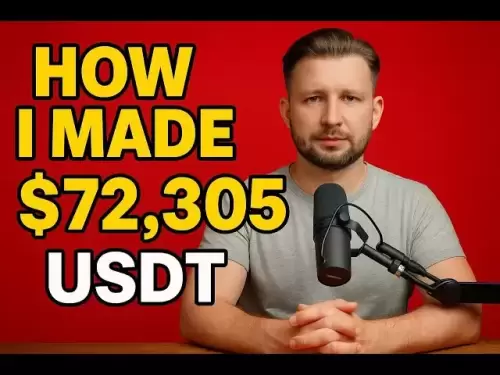 |
|
 |
|
 |
|
 |
|
 |
|
 |
|
 |
|
 |
|
 |
|
 |
|
 |
|
 |
|
 |
|
 |
|
 |
|
Cryptocurrency News Articles
While Ethereum Surged by 43.6% in One Week, Reaching 2,600 Dollars
May 16, 2025 at 03:05 pm
As Ethereum surged by 43.6 % in one week, reaching 2,600 dollars, the prospect of a return to 5,000 dollars

While the cryptocurrency market continues to be a subject of heated debate, with some focusing on Bitcoin’s price and others discussing the possibility of a return to 5,000 dollars for Ethereum, it’s crucial to consider the broader trends at play.
Recently, there has been a surge in interest in Ethereum, especially as the price rose by 43.6 % over the course of one week, sparking discussion among traders and analysts. However, despite this rally, data from CoinShares and Bloomberg Intelligence reveals that institutional appetite for the cryptocurrency remains very limited.
As Adriano Feria, a crypto analyst, pointed out on May 12, 2025, on the social network X (formerly Twitter), Ethereum is "the best candidate for institutional diversification." This is because professional fund managers appreciate "similar levels of regulatory clarity and accessibility" through multiple spot Exchange-Traded Funds (ETFs) for both Bitcoin and Ethereum. However, recent data has not been particularly encouraging.
Indeed, between May 12 and 13, Ether ETFs listed in the United States recorded net outflows of $4 million, a figure sharply contrasting with the positive inflows seen in Bitcoin ETFs. These outflows suggest that institutional investors, despite showing interest in cryptocurrencies in general, might be pulling out of their positions in Ethereum at this stage.
Moreover, the size of the Ether ETF market is still 92 % smaller than that of Bitcoin, which is currently valued at $121.5 billion. This disparity highlights a significant deficit in institutional interest in Ethereum at this stage, leading some players to express skepticism about its ability to truly capture large-scale capital.
However, several upcoming regulatory elements could reverse the trend. For instance, James Seyffart, an analyst at Bloomberg Intelligence, asserts that some progress in terms of approval for the first spot Bitcoin ETF is "highly likely before the end of the year." These measures could radically transform the attractiveness of ETH ETFs.
If the U.S. Securities and Exchange Commission (SEC) approves an ETF on Bitcoin, the largest cryptocurrency by market capitalization, it could quickly mobilize significant institutional inflows towards the asset.
In this context, Ethereum could, in the absence of strong immediate appetite, impose itself by elimination, especially if the SEC refuses to approve ETFs on other altcoins. The lack of direct competition on the institutional field could thus become an unexpected strategic advantage for ETH.
But capital movements and regulatory bets aren’t the only factors to consider. Major technical developments are also crucial for understanding Ethereum’s potential return to its peaks.
The Pectra upgrade brought a clear improvement in data transmission within the network, boosting activity on Layer 2 solutions. According to L2Beat data, activity on these networks grew by 23% in one month, notably driven by Base, which recorded 244.2 million transactions over 30 days.
However, despite this ramp-up, the report by blockchain analytics firm Glassnode indicates that Ethereum’s deflationary momentum remains stalled.
The priority given to scalability via rollups has reduced onchain congestion, limiting burn volumes and calling into question the return to a structurally deflationary ETH in the short term.
Another potential driver of this rise rests on the growing integration of artificial intelligence into the Ethereum ecosystem. Indeed, Eric Conner, a historic Ethereum advocate, mentioned on platform X on May 13 an already observable use case.
ChatGPT prefers Ethereum’s Layer-2 infrastructure to manage funds via multisignature contracts.
This approach would allow autonomous agents to execute payments, rebalance portfolios, or automatically invest in the DeFi. Such automation could multiply smart contract activity on Ethereum to the point of “growing tenfold from its current level”.
Although the actual extent of this adoption is still difficult to predict, the potential of such use, combined with the existing infrastructure, constitutes a strong argument in favor of a return to the top.
Disclaimer:info@kdj.com
The information provided is not trading advice. kdj.com does not assume any responsibility for any investments made based on the information provided in this article. Cryptocurrencies are highly volatile and it is highly recommended that you invest with caution after thorough research!
If you believe that the content used on this website infringes your copyright, please contact us immediately (info@kdj.com) and we will delete it promptly.
-

- Another Prominent Guest Has Been Confirmed for the Highly Anticipated Crypto-Focused Dinner with the 47th President of the United States, Donald Trump
- May 17, 2025 at 02:10 am
- Nikita Anufriev, an influential crypto entrepreneur and founder of the largest Russian-language crypto podcast and community, “Headliners,” will attend the exclusive event
-

-

-

-

- As the hype around Pi Network captures mainstream attention, a new AI-powered contender is quietly gaining serious traction—Lightchain AI.
- May 17, 2025 at 02:00 am
- With its presale already surpassing $20.3 million at a price of just $0.07, Lightchain AI is becoming one of the most talked-about tokens among analysts and early investors alike.
-

-

-

-



























































